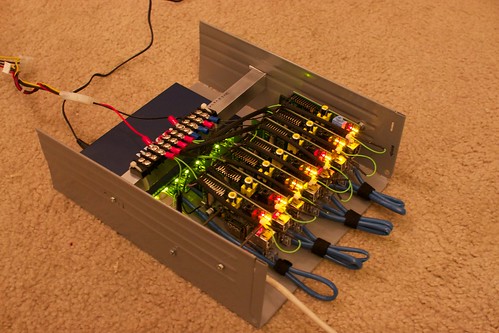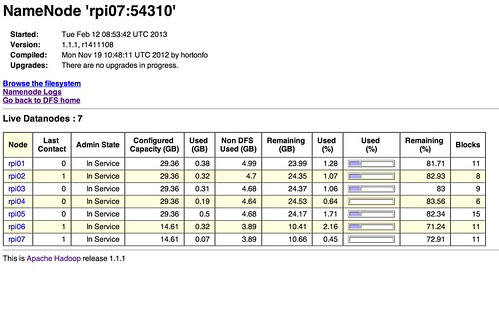tinycluster
Oct 27th, 2013 by bwann
On the heels of the IKEA cluster, I came up with the tinycluster. Inside a HELMER drawer I strung up seven Raspberry Pis on threaded rods and powered them all with the 5v output from a spare ATX power supply.
Instead of using USB for power, I ran DC to pins 1 (5V) and 6 (ground) directly on the Pis. AFAIK they’re not technically GPIO pins, and I have yet to set anything on fire. For power distribution I put some terminal ends on project jumpers, paired them up, and attached one end to a 10-terminal block connected to the PSU, other end to the Pi. I looped a male->female jumper to the front to make it easier to unplug power to an individual Pi if needed.
2018 note: This was built in 2013 with original Raspberry Pi 1 model B units. Newer Pis are more power hungry so I don’t know if this approach is still prudent.
All seven RPis draw about 2.8 amps. Inside the drawer is also an 8-port gigabit network switch with 1 foot jumpers to each RPi. A special construction note, you’ll want 4-40 sized threaded rod/standoffs. I had a really hard time finding it in local hardware stores. The holes in the RPi are intended for PCB manufacturing/prototype mounting and not a general purpouse mount, which explains the extra small size.
Each RPi has either a 16 GB or 32 GB SD card with Raspbian (Debian) Linux on it. Like IKEA cluster, I use Chef to manage the configuration on them. Fortunately the normal Debian Omnibus installer works just fine on RPIs. Likewise I use OpenTSDB tcollectors on the RPIs for various system statistics collection.
Here’s where I installed Hadoop on tinycluster and wrote some files to HDFS:
Previous posts:
Construction photos:

